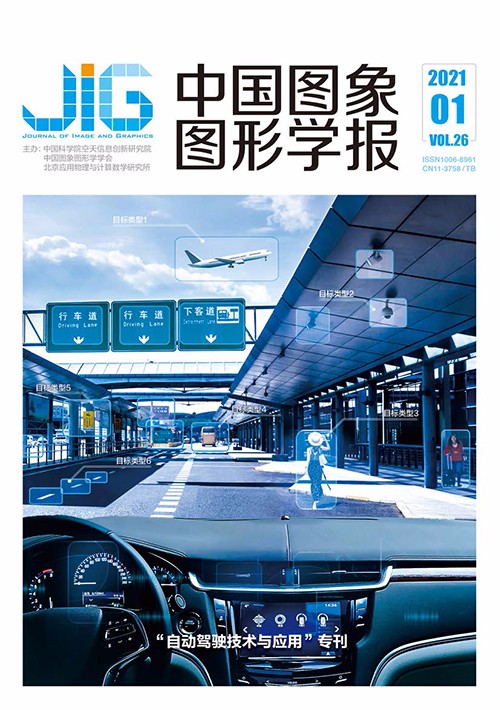
适用全速域大曲率路径的自动驾驶跟踪算法
摘 要
目的 路径跟踪是自动驾驶汽车根据感知、决策和规划结果正确沿道路行驶的关键部分。目前路径跟踪算法难以在全速域、复杂路径场景和高自由度动力学模型下取得优异的性能,并且未考虑与纵向控制的耦合特性,限制了控制算法的跟踪性能。针对以上问题,提出了一种基于速度自适应预瞄的无模型转向控制算法。方法根据车辆与跟踪路径的横向偏差与角度偏差,建立车辆方向盘输出控制量方程,该方法实现了在动力学高度复杂情况和跟踪路径可导情况下的低速稳定跟踪。同时根据车辆纵向速度自适应设置跟踪预瞄距离,并将速度耦合参数加入方程,实现了车辆全速域、全路径的稳定跟踪。结果 本文在PanoSim自动驾驶仿真系统和Simulink仿真软件进行仿真实验,在高自由度动力学模型下,本文算法实现在超高速(>220 km/h)直线及小曲率跟踪路径中横向偏差变化量Δd的模Δd<0.1 m、在高速(>150 km/h)大曲率弯道跟踪路径中Δd<0.3 m的性能。结论 本文提出的基于速度自适应预瞄的无模型转向控制算法可以实现全速域、大曲率的路径稳定跟踪。
关键词
Autonomous vehicle tracking algorithm for high curvature path in full speed range
Zhang Yan1, Zheng Ying1, Bao Hong1,2(1.China University of Mining & Technology(Beijing), Beijing 100083, China;2.Beijing Union University, Beijing 100101, China) Abstract
Objective Path tracking is the key part of an automatic driving vehicle running along a road according to the perception system and decision system results. The control module involved in path tracking is the lowest-level software algorithm module of autopilot, which includes two parts: lateral control and longitudinal control. Steering control is mainly responsible for vehicle steering output control, and longitudinal control is mainly responsible for throttle and brake control. The steering control algorithm tracks and controls the path of the two upper frameworks on the basis of perception and decision, and it optimizes the tracking error to ensure the stability and comfort of the self-driving vehicle. Current tracking algorithms mainly include model-free lateral control algorithm and model-based lateral control algorithm. The representative of model free lateral control algorithm is proportion integration differentiation (PID) control. The PID algorithm is difficult to use in controlling automatic driving vehicles without considering the physical characteristics of the vehicle and in high-speed and complex environments. The model-based lateral control algorithm includes the lateral control algorithm based on vehicle kinematics model and the lateral dynamics algorithm based on vehicle dynamic model. The former is represented by the Stanley method based on front-wheel feedback and rear-wheel control based on rear-wheel feedback. The latter is represented by the lateral control algorithm of linear quadratic regulator based on the dynamic model. Algorithms based on the vehicle model need to accurately model the kinematic or dynamic characteristics of the vehicle and usually need to simplify the model to predict the state of vehicle tracking deviation by simplifying the modeling of the model. This approach thus achieves accurate control of the vehicle. In addition, these two lateral control algorithms do not consider the coupling characteristics with longitudinal control, which limits the tracking performance of the control algorithm. To address the problems of high-complexity vehicle model and current path tracking algorithm, this paper proposes a model free-steering control algorithm based on speed-adaptive preview. Method In the face of highly complex or unknown dynamic performance of the vehicle dynamics model, accurately calculating the state equation of vehicle path tracking deviation through dynamic characteristics is impossible. However, due to the complex dynamic characteristics, the control quantity obtained through kinematic characteristics will cause many errors, especially in the case of high-speed driving, large curvature, and nondifferentiable path. The cumulative error of these two methods may lead to a self-driving car going out of control. Therefore, the model-free control method can achieve stable and accurate path tracking performance in the full speed range under complex dynamic conditions. Considering the stable tracking in scenes with non-conductance and large curvature, this paper uses the speed-adaptive preview method to enhance the stability of autopilot under complex road conditions. According to the intelligent driving vehicle model studied in this paper, the control input includes the lateral distance difference between the vehicle and the tracking path, the angle between the vehicle and the tracking path, and the coupling parameters of the longitudinal speed of the vehicle. The output of the control algorithm includes the steering wheel angle, the throttle opening, and the brake master cylinder pressure. The former mainly controls the direction of the vehicle, while the latter controls the forward speed. In this paper, the output control equation of vehicle steering control is established first according to the deviation distance and angle between the vehicle and the tracking path. This method realizes stable tracking at low speed under the condition of highly complex dynamics and differentiable tracking path. At the same time, the tracking preview distance is set adaptively according to the vehicle longitudinal speed, and the speed coupling parameters are added to the equation to realize the stable tracking of the vehicle in the full speed range and all types of paths. Result To verify the proposed path tracking algorithm based on speed-adaptive preview, we participated in the 2020 China Intelligent Vehicle Championship and World Intelligent Driving Challenge online simulation competitions. In this experiment and competition, PanoSim automatic driving simulation system and Simulink simulation software are used for the simulation experiment. The test road is a 10 km test freeway provided by Panosim, and it includes five sections with large curvature and five sections with small curvature. In this paper, we select a typical section of the small curvature section and large curvature section to test the algorithm. Under the dynamic model with a high-degree-of-freedom dynamic model, the proposed algorithm can achieve the performance of lateral deviation Δd< 0.1 m on the ultra-high speed (>220 km/h) straight-line, and small-curvature tracking path, and Δd<0.3 m on the high-speed (>150 km/h) high-curvature curve tracking path. Conclusion In this paper, the path tracking algorithm based on speed preview is proposed, and the model free lateral control algorithm is studied to realize the control coverage from a simple to a complex vehicle model; the optimization of vehicle lateral control by a speed coupler is studied to realize the full speed range control coverage of the vehicle; and the controller based on speed-adaptive preview is studied to realize the transition from the differentiable path to the nondifferentiable path. To some extent, the problem of control hysteresis and overshoot is solved.
Keywords
|



 中国图象图形学报 │ 京ICP备05080539号-4 │ 本系统由
中国图象图形学报 │ 京ICP备05080539号-4 │ 本系统由